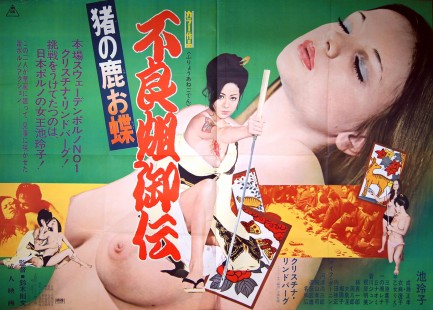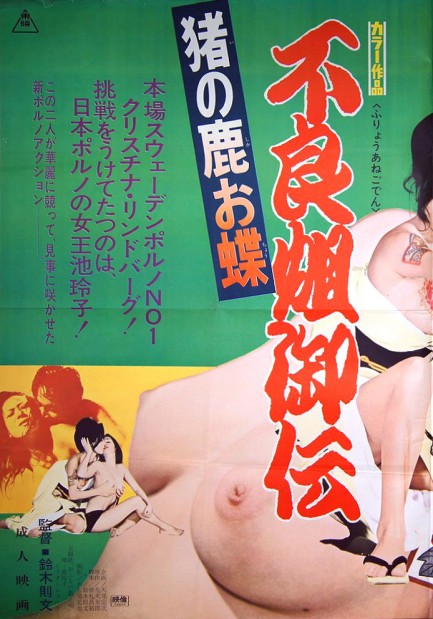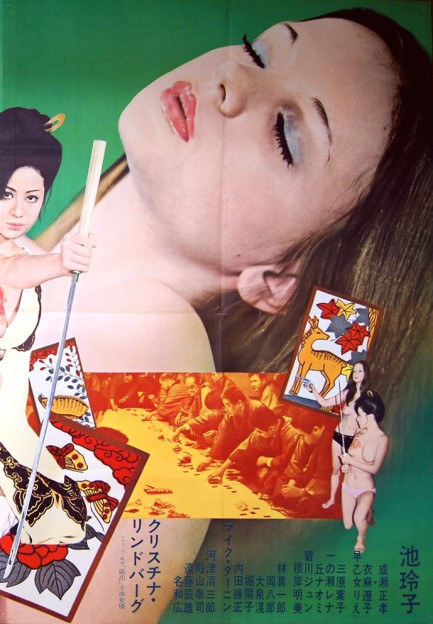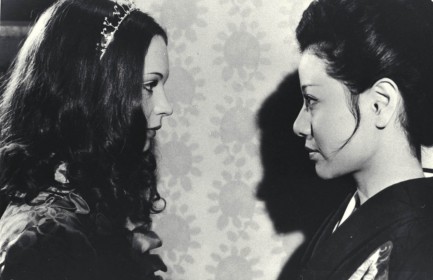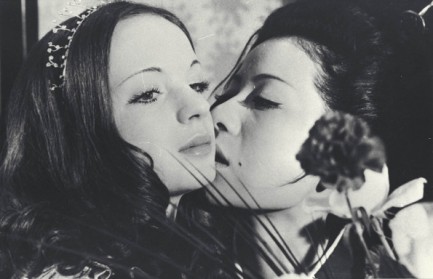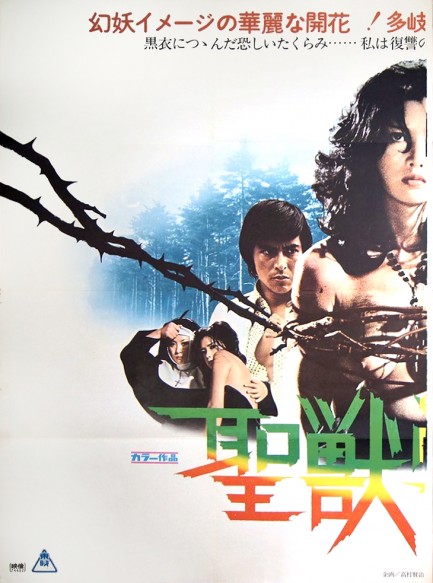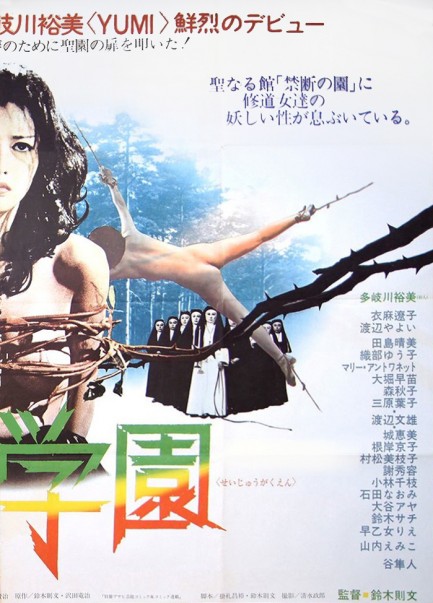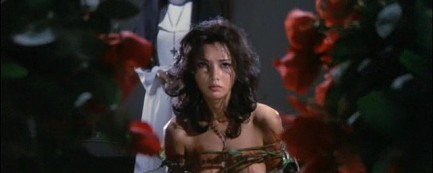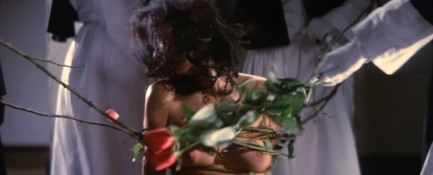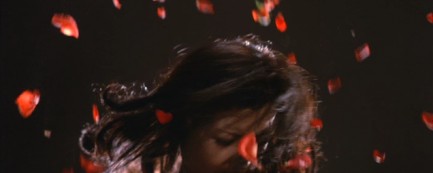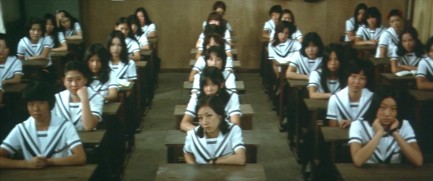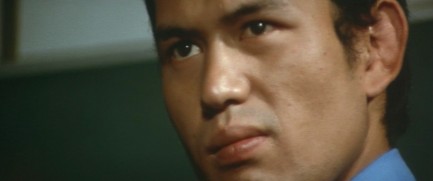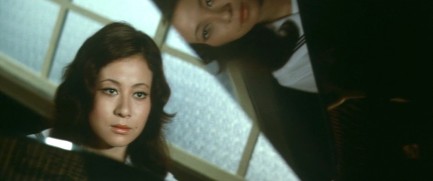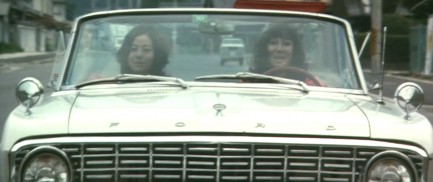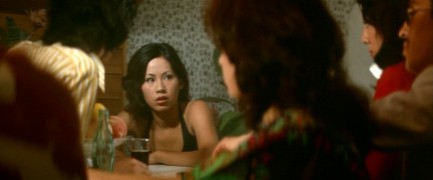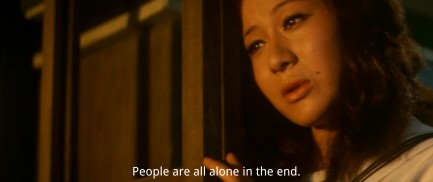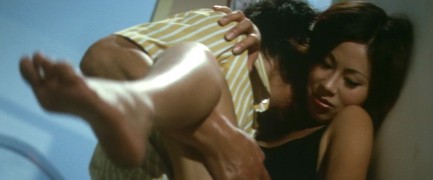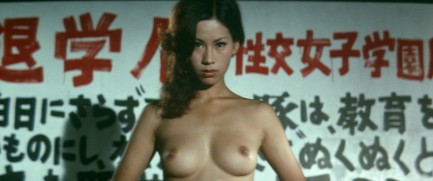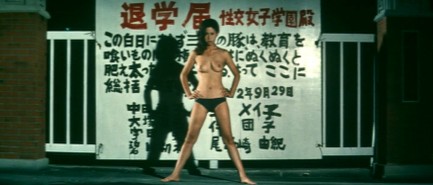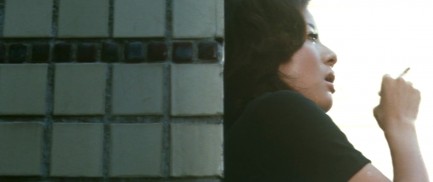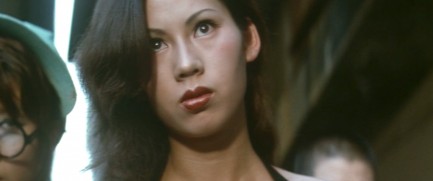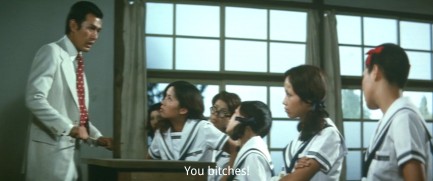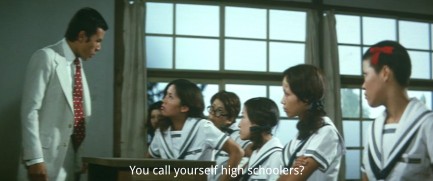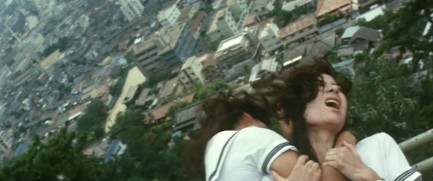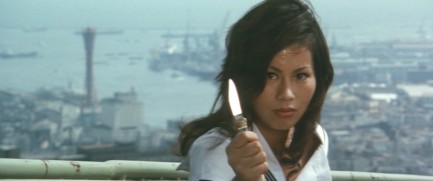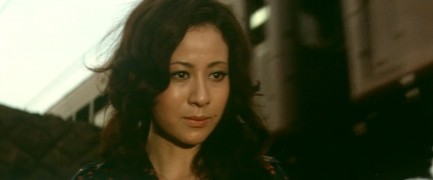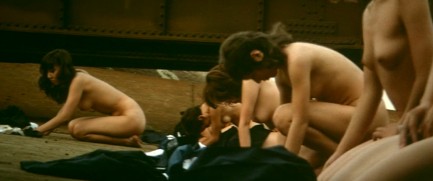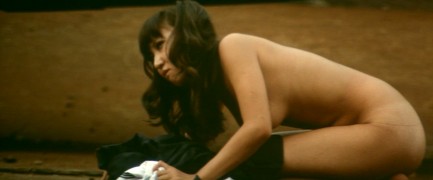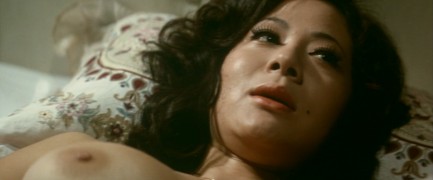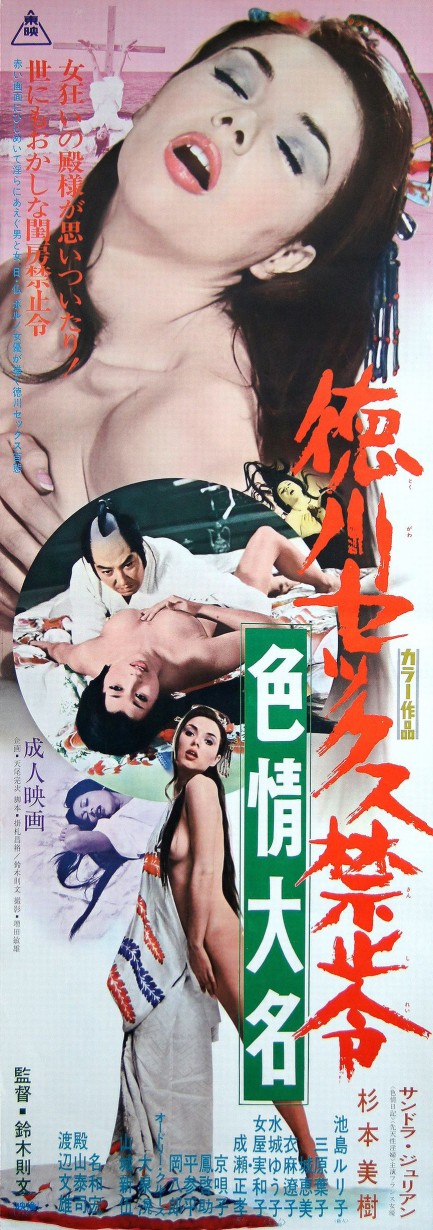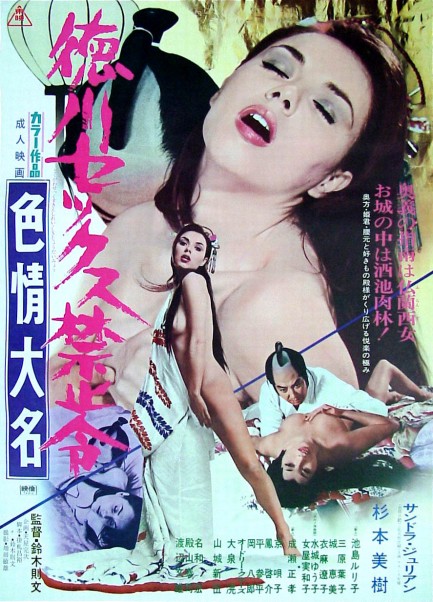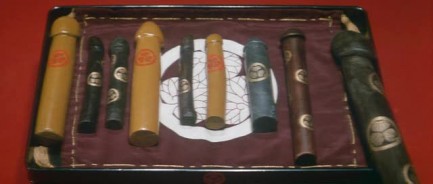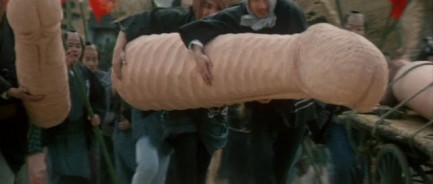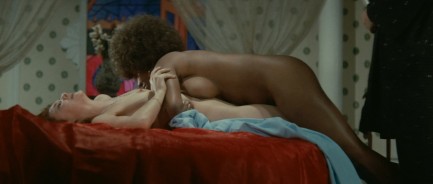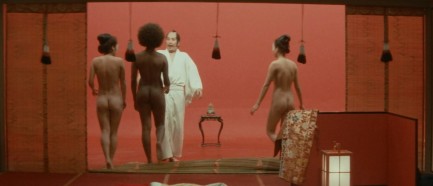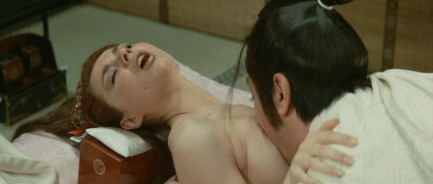 This flower is toxic—to thieves and killers. 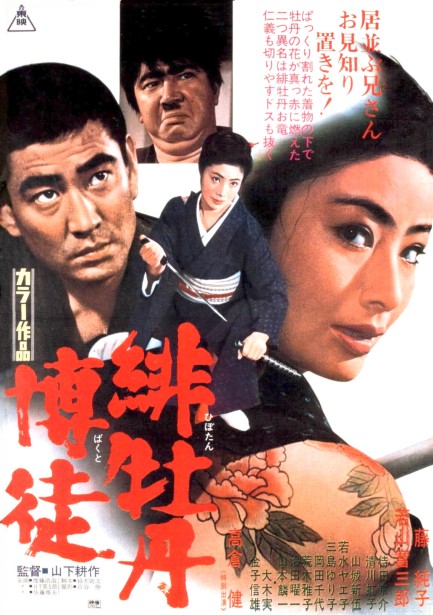
We've been on a movie binge, so we have one to discuss for the third day in a row. Above is a poster for the 1968 action-drama Hibotan bakuto, aka Red Peony Gambler. It's fair to call the film a classic. It was directed by the legendary Norifumi Suzuki, and starred Junko Fuji and Ken Takakura. Fuji plays a wandering gambler seeking retribution for her father, who was murdered by an unknown bandit. The killer left behind one clue—a distinctive cloth wallet that Fuji now carries with her. Ultimately she finds her father's killer. No surprise there—that's the entire point. But revenge, unsurprisingly, is more complicated than she'd imagined.
When a movie spawns multiple sequels it's a safe bet it's good, and this one had seven follow-ups. Hibotan bakuto has nearly everything you want from a sword opera. The choreographed action, while not fully convincing, is fun. The direction and cinematography are excellent. And Fuji crafts an interesting performance, staring unblinkingly into the middle distance, looking grim, exuding a compelling coolness and self-containment. Overall, we found the movie very worthwhile. We'll check out at least one or two of the sequels and report back. Hibotan bakuto premiered in Japan today in 1968.
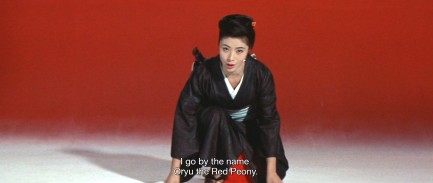 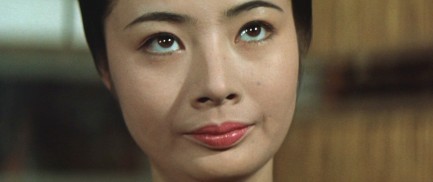 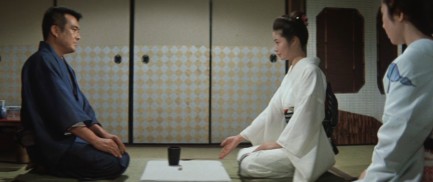  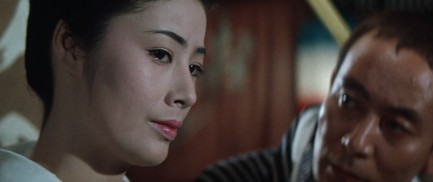 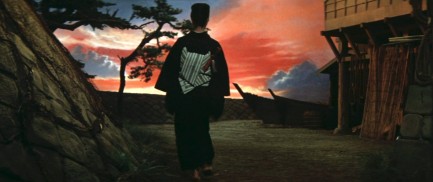
 Miki and Reiko rock and rule Osaka in 1973's Sukeban. 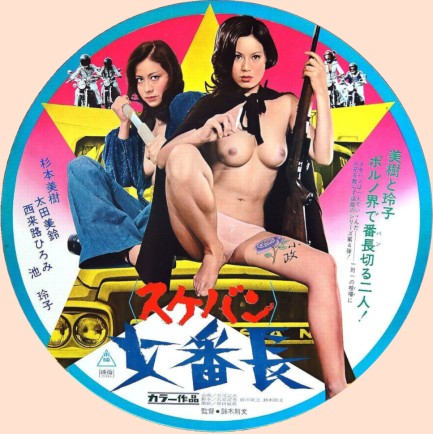
We already shared this rare circular poster for Sukeban, aka Girl Boss Revenge: Sukeban, in a group post years ago, but since it's so rare and interesting we're bringing it back for a solo look, and as you see below we've split it in half to allow you to have your own copy of reasonable size, if you're inclined to put the two pieces together. We might as well comment on the movie too. When we first shared the art for this, we figured why discuss the film in detail when there were already plenty of reviews online? We even linked to one back then. Little did we know that Pulp Intl. would still be going ten years later and would be a top repository for vintage Japanese poster art online. That being the case, we figure we'll tell you about the movie this time.
It stars two of the brightest stars of the Japanese grindhouse era—Miki Sugimoto and Reiko Ike. Miki plays a gang leader who calls herself Kantô Komasa, while Reiko is the girl gang leader of Namairu High School. They meet in a prison van and escape simultaneously, headed different directions but destined to cross paths again. Miki forms a new gang in Osaka called Gypsy Dance, gets into the usual delinquency, and meets a director of dirty movies who she enlists in a revenge plot. But all the fun and games take a nasty turn when she runs afoul of the North Dragon yakuza and they start dishing out pain and suffering. Only with the help of a young North Dragon footsoldier named Tatsuo is Miki able to escape her predicament.
It just so happens that Tatsuo is Reiko's boyfriend. Reiko has been missing since her escape from the prison van, but arrives on the scene just in time to find Miki in bed with her man. That puts Reiko and Miki at odds in the worst way, but Reiko has no idea Tatsuo is working for the North Dragon. She'll find out, though, via a stunning betrayal. We'll end the synopsis there, but add the warning that the North Dragon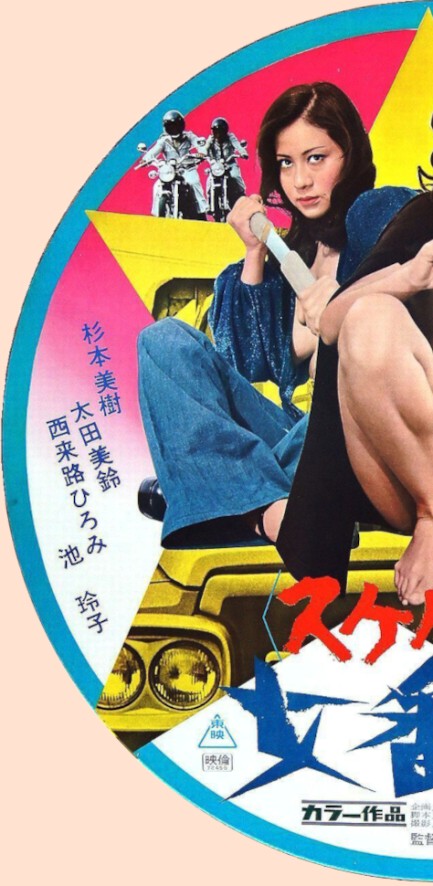 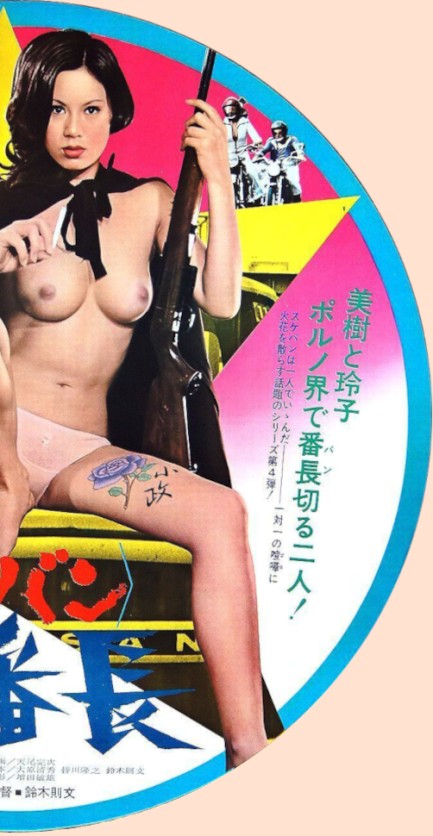 are mean as hell and the tortures they administer are hard to watch. But gangsters gonna gangster—if they spent their time at garden parties and poetry readings there'd be a different word for them. are mean as hell and the tortures they administer are hard to watch. But gangsters gonna gangster—if they spent their time at garden parties and poetry readings there'd be a different word for them.
Sukeban, which was directed by Norifumi Suzuki, is a prime example of Toei Company's pinky violence genre—wild, colorful, gritty, and bloody, with moments of humor to leaven the hard tone. Movies of this style influenced many later directors, but apart from Quentin Tarantino and maybe a couple of other mavericks such operatic exploitation is a relic of the past. The film is basically Miki's show, and whether rolling fabulously down a hill in her fur coat and platforms or getting dirty in an alley fight, she delivers a freewheeling performance in a production that isn't for the faint of heart. It's worth watching for its historical value as well as for entertainment, but in either case, hold onto your hat.
As a bonus, below we have some production photos, including a rare image of Miki striking the topless pose used to create the promo poster. We always thought her head looked a little warped on that poster. Turns out it's a defect in the original photograph—someone either shot her off-kilter or introduced the flaw during the developing process, and she stayed that way. We're guessing, but we're pretty sure because normally her head is very symmetrical. As is the rest of her. You'll see what we mean below about the photo. Sukeban premiered in Japan today in 1973. You can see our other write-up on it here.
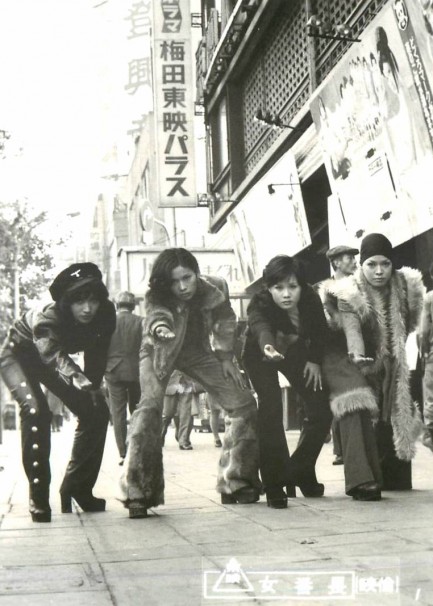 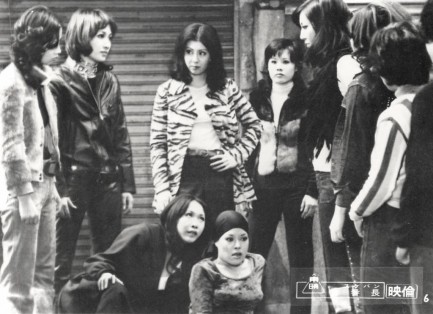 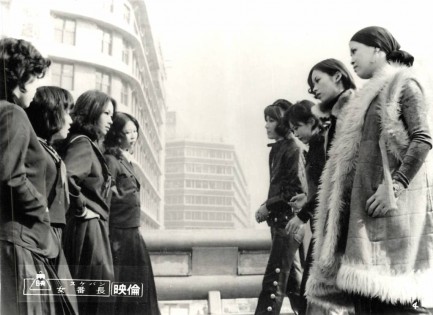 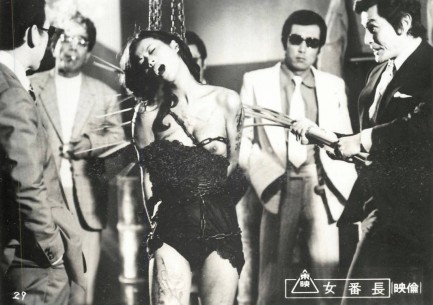 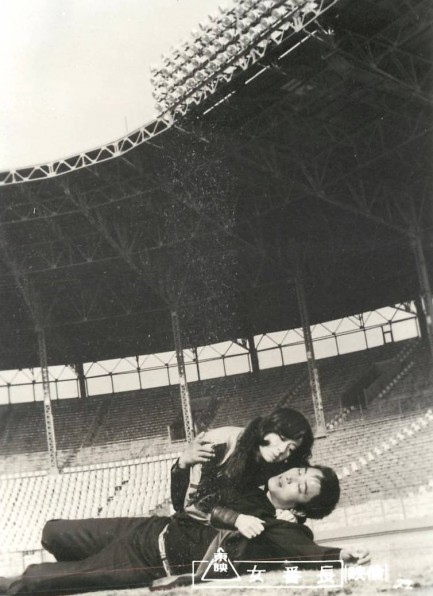 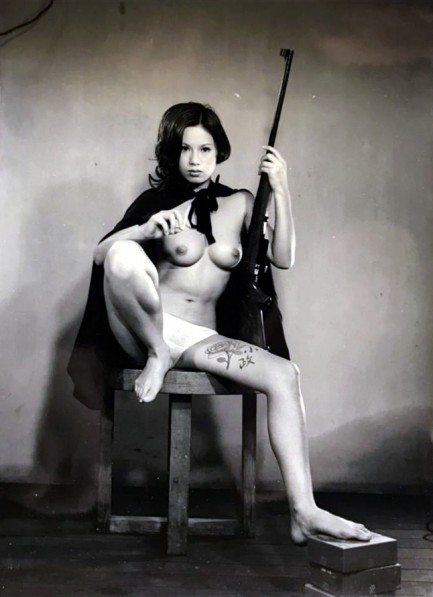
 If you're looking for a tale with a happy ending look somewhere else. 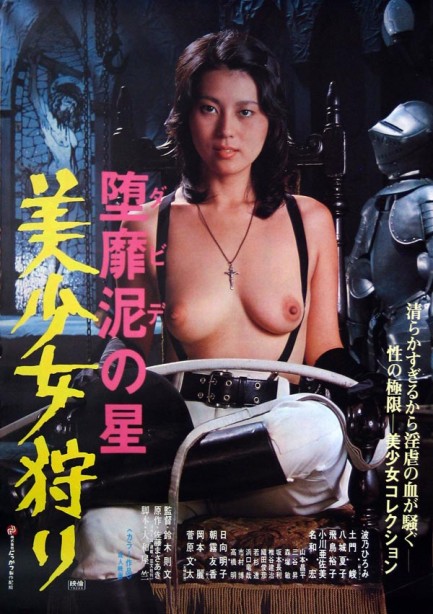 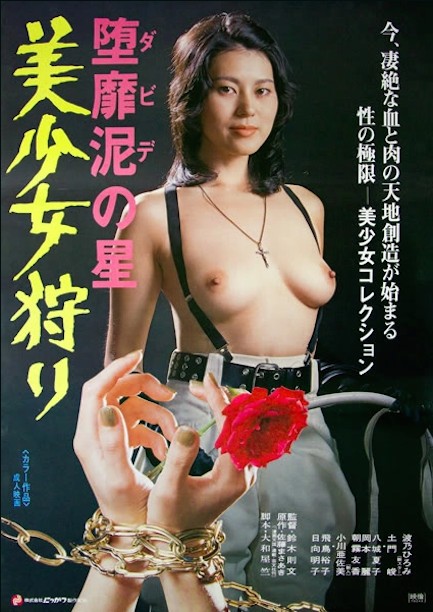
We're doing a pinku double-dip today because life is short and the shit we want to post keeps piling up. Even at an increased rate it'll take another ten years to get this stuff uploaded. Will websites as we understand them even exist then? Will blogs exist? We've already read that blogging is dead. Multiple times. Well, we keep chugging along, and today's journey involves two more promos, these for Nikkatsu Studios' infamous roman porno drama Dabide no hoshi: Bishôjo-gari, aka Beautiful Girl Hunter, which is based on a Maasaki Soto manga and premiered in Japan today in 1979. That's Hiromi Namino on the art, who as far as we know made only one other film.
So we watched this, and yup, it's twisted. Long story short, an escaped lunatic commits a rape which results in a pregnancy, and the rape child grows up to become a rapist. Every taboo is shattered in this one, including ones you've never imagined. As we always note for readers unfamiliar with this genre, there's no actual sex, no frontal nudity. Everything is done with camera angles, the power of suggestion, and acting. Still... holy fuck. But what you really want to know is whether the movie is any good. Objectively it's well made, but it also made us question whether liking roman porno posters and being interested in the genre's history and culture are sufficient enough reasons to keep watching the films.
Yet there are also serious points in this movie about intergenerational violence, and whether it's at all possible for parents to love (or even treat decently) a child conceived via rape. To us, neither question feels responsibly examined enough to justify the existence of the movie. After all, it's first and foremost a piece of sexploitation, and the steady supply of nudity sort of undercuts any serious intent. We much prefer Toei Company's pinky violence films. The women in those either win or cause a hell of a lot of trouble trying. By contrast films like Beautiful Girl Hunter feel deliberately regressive, as we've noted before. These Nikkatsu guys will be the end of us yet. 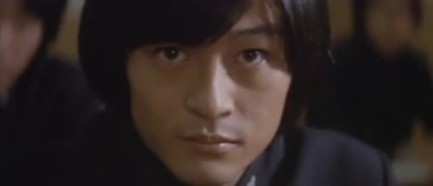 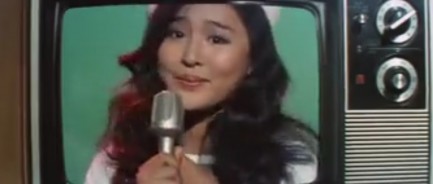 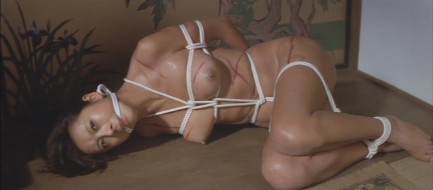  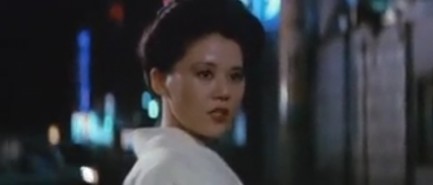 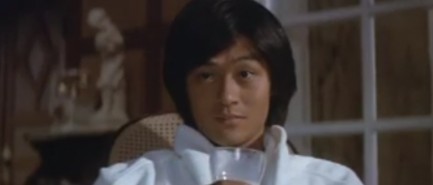 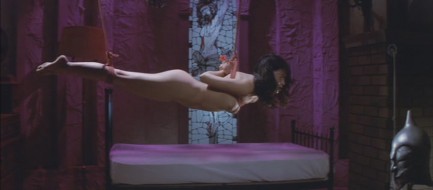 
 There isn't much chasing in The Great Chase but the movie is definitely great. 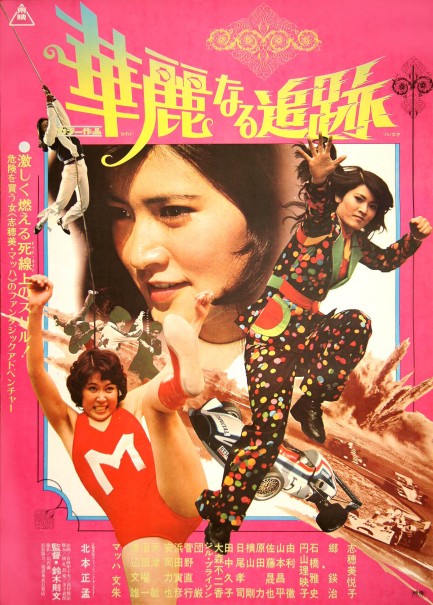
Norifumi Suzuki's Karei-naru tsuiseki, aka The Great Chase is fast, funny, and bizarre entertainment. Etsuko Shihomi plays a Formula 1 driver who also works for the Japanese secret service, in this case taking down an international drug syndicate. Shihomi was already a star in Japanese cinema from her supporting roles in Sonny Chiba's Streetfighter and its spin-offs. Karei-naru tsuiseki sees her honing her solo chops—literally, as she karates the shit out of dozens of guys. But you get so much more than fistfights here—you get Shihomi in disguises, a corpse filled with cocaine, a girl in armor being force fed a banana, a nun brawl in a church, a mob boss dressed as a bear, a fight on what has to be the world's highest cable car, and more. Pure cheese, but of the most flavorful sort, and with a top notch promo poster featuring Shihomi in a discolicious polka dot two-piece. We have posters for five other Shihomi actioners and she looks badass on all of them. We'll share those in the future. Karei-naru tsuiseki premiered today in 1975. 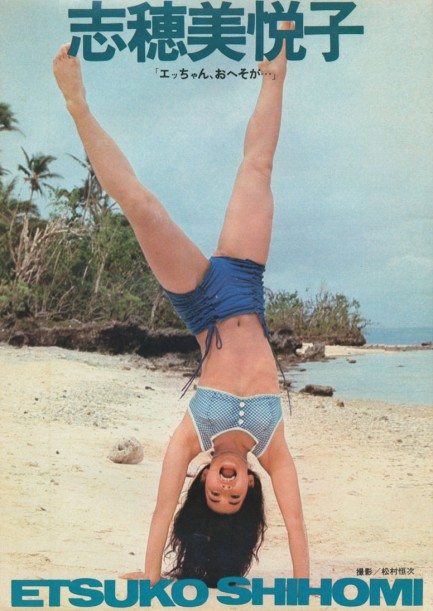
 Who said life couldn’t be a bed of roses? 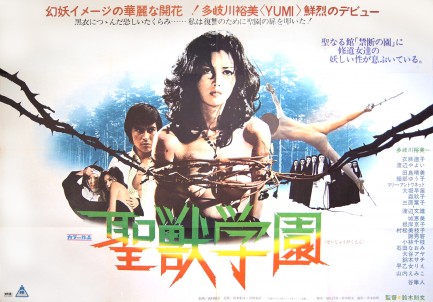
Way back in 2009 two promos for Seijû gakuen were the first pinku posters we ever shared on Pulp Intl. Ah, the good old days. We got the title wrong and misspelled the name of the star, but other than that, what a glorious memory. When we located that pair of posters we also found two others, and now, years later, we’re getting around to sharing those too. Seijû gakuen was known in the West as School of the Holy Beast, and above you see a rare two panel horizontal poster. At that orientation it renders a little small here, so we’ve posted the panels seperately below:
The second poster we wanted to share is a somewhat less colorful effort, but still quite nice, with a splash of rose pink in the middle. You see that below:
In addition to starring Yumi Takigawa, Seijû gakuen had Emiko Yamauchi and Pulp fave Yayoi Watanabe, and as we mentioned in the previous post, it’s nunsploitation from Toei Studios. As you no doubt have deduced, Takigawa goes through all kind of indignities, and at one point is bound with vines and whipped across her naked torso by two nuns using bouquets of roses (and, more importantly, their thorns). It’s a bizarre and bloody but beautifully shot spectacle.
Lastly, just below, we’ve decided to share a promo image of Yumi Takigawa looking her radiant best. She spends a good portion of the movie wearing a nun’s habit that covers everything except her face. If Toei and director Norifumi Suzuki wanted a lead actress whose face could be isolated in that manner yet still hold an audience’s attention they succeeded. Seijû gakuen was Takigawa’s first film but not her last—she’s still quite busy as an actress, appearing mainly on television. Seijû gakuen premiered today in 1974. 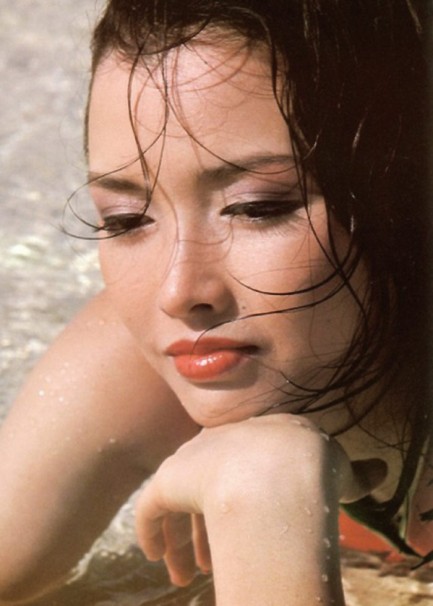
 The secret life of flowers. 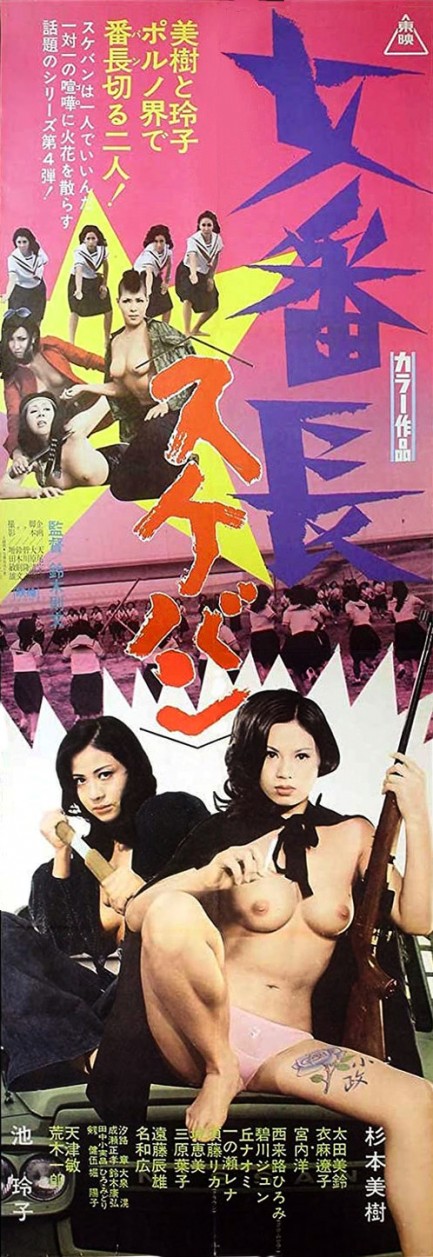
There’s quite a bit of information about Norifumi Suzuki’s pinky violence masterpiece Sukeban, aka Girl Boss Revenge: Sukeban on the web already, so we don’t need to add to it. And if you’re looking for posters, the promo art for this film is also abundant. But we can’t really call ourselves one of the go-to spots for pinku art without featuring this classic, so we have said poster above, with avenging angel Miki Sugimoto sporting a rose tattoo on her thigh, and co-star Reiko Ike lurking in the background. Keep an eye out on Pulp Intl.—we have an amazing nude promo poster of Sugimoto, never before seen on the internet, that we’ll be sharing in the next few weeks. Sukeban premiered in Japan today in 1973.
 Think you hated school before? Just wait. 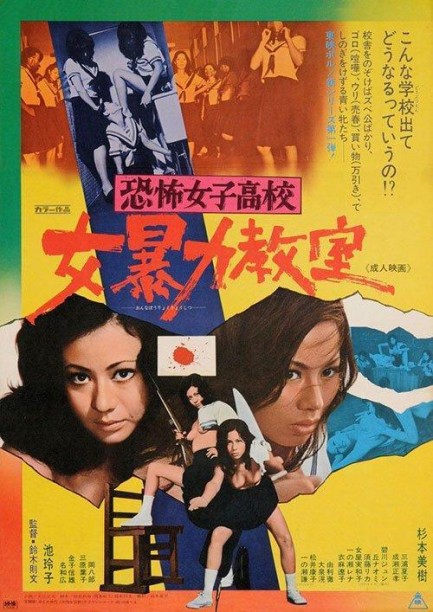 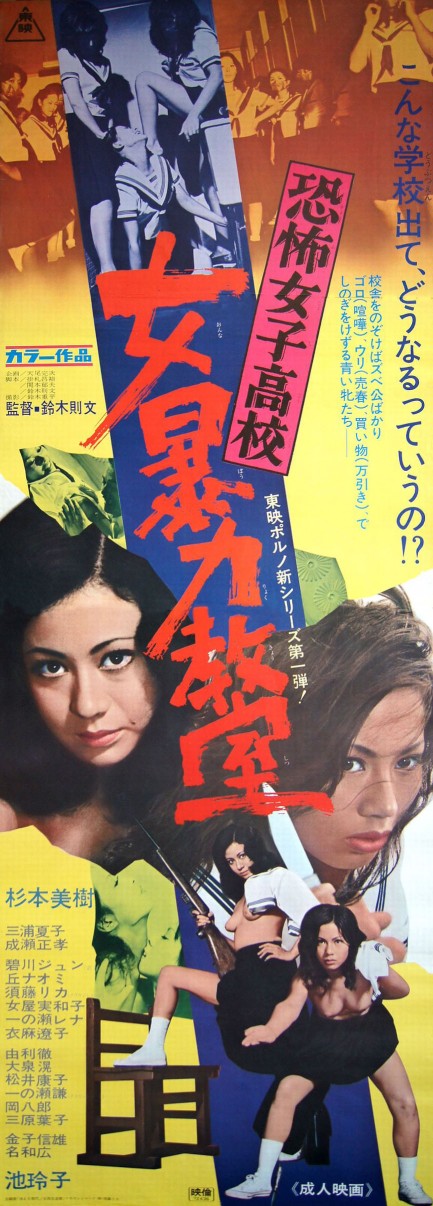
Above are two posters for Norifumi Suzuki’s pinky violence flick Kyôfu joshikôkô: Onna bôryoku kyôshitsu, aka Terrifying Girls High School: Women’s Violent Classroom, with Reiko Ike and Miki Sugimoto. This was first in a four film series, followed by Lynch Law Classroom, Delinquent Convulsion Group, and Animal Courage. Sugimoto is the ringleader of a girl gang at Seiko High School, beating up other students, bullying them for money, bombarding a teacher with condoms and panties, leaving a dead cat hanging in class, even engaging in a little blackmail. Why is Miki such a problem? A couple of years earlier she was raped, and now she has changed from, in her words, “the raped to the one who rapes.” Do you have any doubt at all that a man wrote that?
So okay, Miki, driven by past trauma, runs the school like a despot queen, but her reign of terror hits a snag when another very tough girl is transferred there. That would be none other than Reiko Ike, who joins forces with Miki's main rival. It's pure pinky violence action from that point on, as faces are slapped, hair is pulled, dresses are ripped, and boobs are burned with cigarettes. They play rough, these high schoolers. Meanwhile a new teacher known as a disciplinarian comes to Seiko High and tries to be understanding with these she-devils, but when pushed past his breaking point is soon body slamming them. Never one to back down, Miki arranges for the teacher's wife to be gang raped. She wants to retain control of her high school fiefdom and there's no limit to what she'll do. But Reiko? She has a totally different agenda.
Both Sugimoto and Ike were nineteen when they made this film, and both look perfect for their roles—young but a bit hardened. Since pinku movies involve a lot of steely glares, they depend greatly upon the actresses' ability to impart meaning with facial expressions. Sugimoto and Ike are both good at that. These are also physical movies, with gang fights that resemble choreographed group dances. Ike was particularly adept at this and would later film one of the famed fight scenes in film history in 1973's Sex and Fury, a nude sword battle against a half dozen men who surprise her in the bathtub. She and Sugimoto rode their many abilities to greater stardom throughout the mid-1970s. Working here together, you can really see their talent. Kyôfu joshikôkô: Onna bôryoku kyôshitsu premiered in Japan today in 1972.
 Reiko Ike chops off her enemies’ heads so they can be topless too. 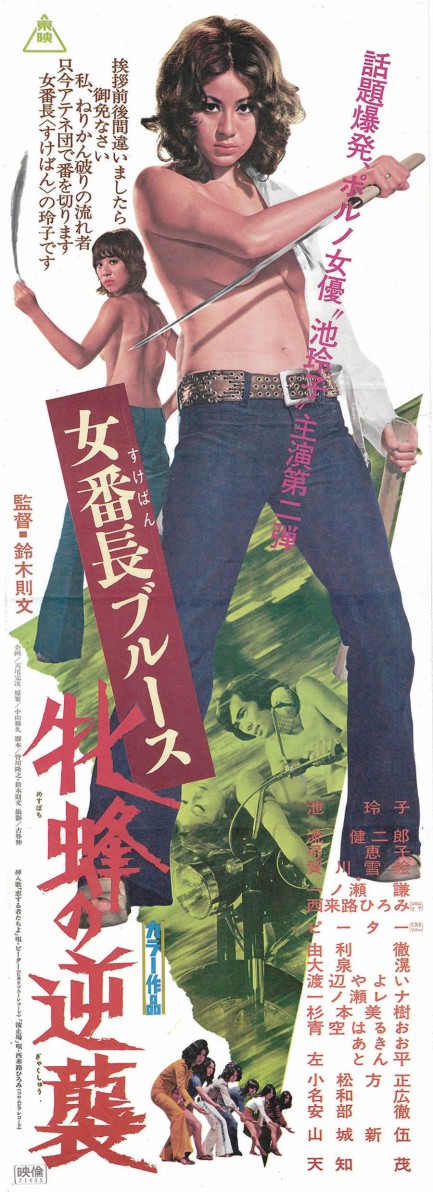
Sometimes you just have to have a little Reiko Ike, so we brought her back today on a poster from her 1971 sword opera Sukeban burûsu: Mesubachi no gyakushû, aka Girl Boss Blues: Queen Bee Strikes Again, aka Girl Boss Blues: Queen Bee's Counterattack. In this first installment of the Girl Boss series, Reiko plays the leader of the Athens girl gang, who use thier bodies to engage in blackmail for profit. She breaks in a fresh young gang member, finds heself in a rivalry with a newly arrived veteran criminal played by Yukie Kagawa. Disobedient Kagawa instigates a blackmail plot—without Reiko's permission, uh oh—that has the potential to rock Japanese society. There's even more going on here plotwise, but the main thing is that, as usual, Reiko finally decides to make a big score and a lot of violence results. While this isn’t the strongest of director Norifumi Suzuki’s films, it’s pretty entertaining. It's got the requisite portions of sex, violence, and audacious shock. Oh, and we should mention it has a famous group sex-on-motorcycles scene you should probably see. For fans of the genre, that’s probably more than enough by itself. But in case it isn't, Ike's gang includes Miki Sugimoto, Yayoi Watanabe (both below), and other hotties. Sukeban Blues: Mesubachi no Gyakusyû premiered in Japan today in 1971.
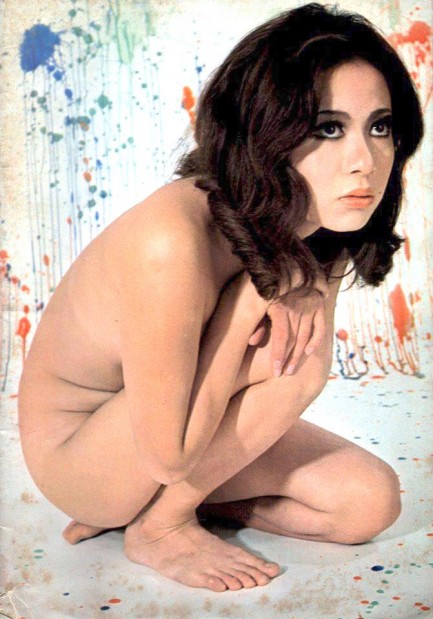 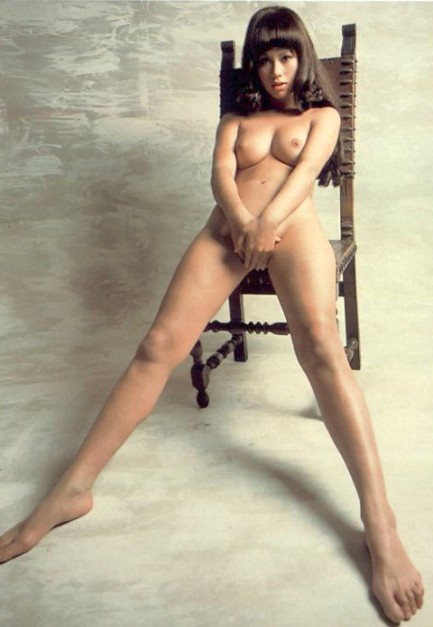 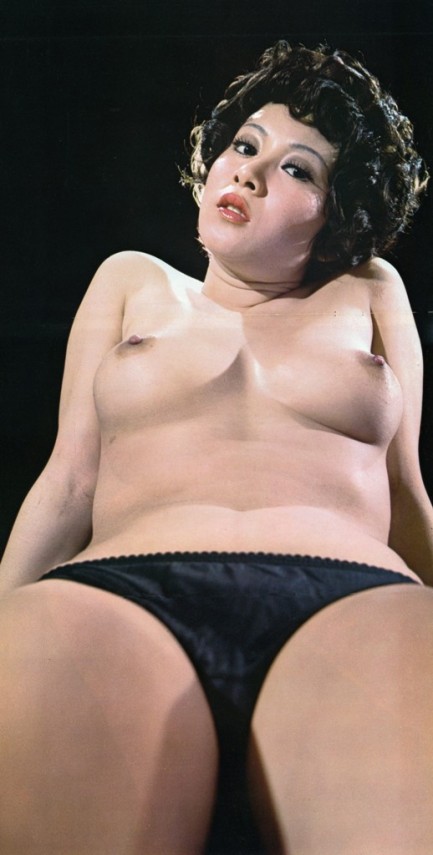

|
 |

The headlines that mattered yesteryear.
2003—Hope Dies
Film legend Bob Hope dies of pneumonia two months after celebrating his 100th birthday. 1945—Churchill Given the Sack
In spite of admiring Winston Churchill as a great wartime leader, Britons elect
Clement Attlee the nation's new prime minister in a sweeping victory for the Labour Party over the Conservatives. 1952—Evita Peron Dies
Eva Duarte de Peron, aka Evita, wife of the president of the Argentine Republic, dies from cancer at age 33. Evita had brought the working classes into a position of political power never witnessed before, but was hated by the nation's powerful military class. She is lain to rest in Milan, Italy in a secret grave under a nun's name, but is eventually returned to Argentina for reburial beside her husband in 1974. 1943—Mussolini Calls It Quits
Italian dictator Benito Mussolini steps down as head of the armed forces and the government. It soon becomes clear that Il Duce did not relinquish power voluntarily, but was forced to resign after former Fascist colleagues turned against him. He is later installed by Germany as leader of the Italian Social Republic in the north of the country, but is killed by partisans in 1945.
|

|
|

It's easy. We have an uploader that makes it a snap. Use it to submit your art, text, header, and subhead. Your post can be funny, serious, or anything in between, as long as it's vintage pulp. You'll get a byline and experience the fleeting pride of free authorship. We'll edit your post for typos, but the rest is up to you. Click here to give us your best shot.

|
|











 are mean as hell and the tortures they administer are hard to watch. But gangsters gonna gangster—if they spent their time at garden parties and poetry readings there'd be a different word for them.
are mean as hell and the tortures they administer are hard to watch. But gangsters gonna gangster—if they spent their time at garden parties and poetry readings there'd be a different word for them.

















